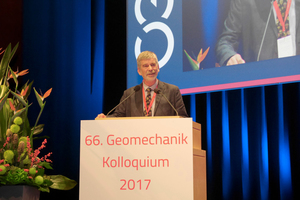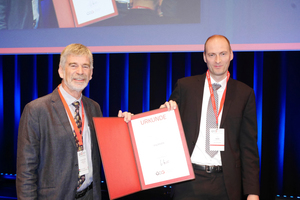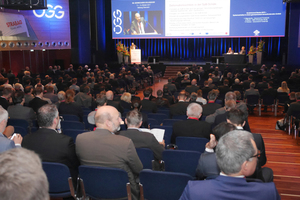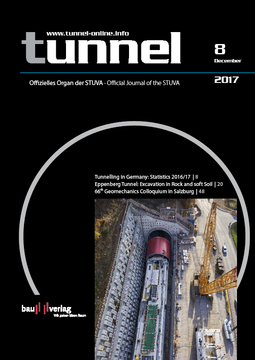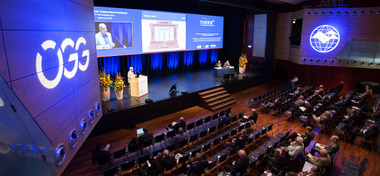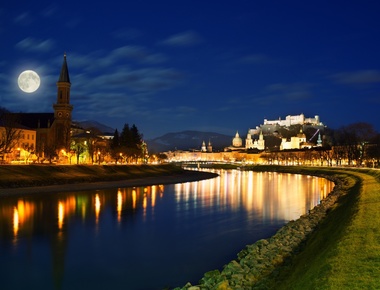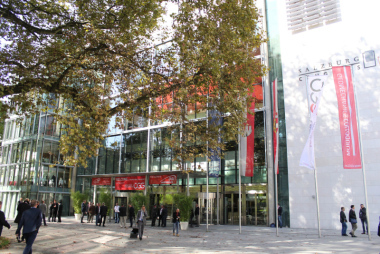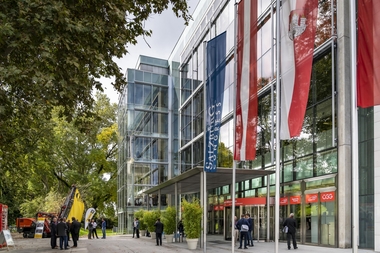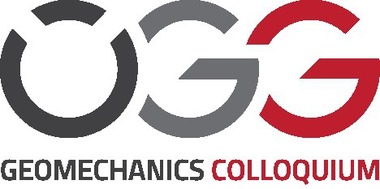66th Geomechanics Colloquium in Salzburg
This year’s Geomechanics Colloquium held by the Austrian Society for Geomechanics (ÖGG) from October 12 to 13, 2017 in Salzburg was again one of the top events in its field in the German-language speaking world. It attracted more than 800 participants – as well as a further 200 persons (drawn from three vocational school classes, exhibitors and a large number of advisors connected to the exhibition). During the breaks, visitors thronged the booths belonging to the 57 exhibitors and 12 university institutes in order to exchange views and discuss topical projects as well as possible orders.
“Once again the ÖGG has a very interesting programme of lectures to offer with four half-day topics, namely the geomechanical aspects of current tunnel projects and the refurbishment of infrastructure today on Thursday as well as an engineering geological documentation, examining the problems of changing geologies, and various aspects of planning, dimensioning and surveillance connected with producing headrace tunnels tomorrow on Friday”, is how Univ.- Prof. Dr. Wolf Schubert (Fig. 1) introduced the participants to the extensive programme in his welcoming speech.
This was done in his old and new function as chairman of the board –
on October 11, 2017, practically the entire board were confirmed in office for a further term as from January 1, 2018 at the recurring election. New to the board are Dietmar Bach, who replaces Andreas Leitner to take charge of financial affairs, and Dr. Andreas Goricki, taking over from Univ.-Prof. Dr. Rainer Poisel, who has stepped down from supervising the section for rock mechanics and rock construction.
In addition to the ÖGG board meeting on the evening of October 12,
2017, three workshops were held during the day. They are staged every second year alternating with the “Tunneltag” (Tunnel Day), which also takes place up front and will be held again in 2018.
Experiences with the new ÖGG Guideline
At the first workshop involving around 65 participants the experiences
gained with the ÖGG Guideline “Geotechnical Planning with continuous Excavation” were exchanged. It was first published in 2001 and revised in 2008. Findings with applying the guideline in practice were discussed; suggestion for improvements and amendments
were put forward and updating the guideline on the basis of the results achieved contemplated.
Continuation of the Workshop on “Grouting”
Some 110 participants discussed their experiences with applying the most customary grouting agents in transport tunnel construction at the second workshop and when producing high-pressure hydro power plants. A well attended workshop on “Grouting” already took place two years ago, albeit it concentrated on other aspects. Following an introduction to the fields of application with the presentation of the principles, scope of operation and material technologies, practical use was resorted to that involved various grouting agents and their most essential material properties. Testing was also featured and explained. Subsequently the participants were presented with extensive reports dealing with findings and applications from planning, tendering and execution, resulting in a lively debate.
Rock Mechanics in revised Eurocode 7
The third workshop involving around 36 participants examined the somewhat subordinate role played so far by rock mechanics and rock construction in Eurocode 7 (EN 1997). The revision process finds itself in a decisive phase in 2017. A version with proposals for changes drafted by Project Team 2 of the Eurocode 7 Committee was discussed in order to assure the applicability of the Eurocode 7 in rock mechanics and rock construction as well.
Leopold Müller Prize 2016
In spite of all the activities the previous day, the Leopold Müller Prize 2016 presentation ceremony was well attended. The prize is awarded on a yearly basis during the Geomechanics Colloquium held the following year. The award on this occasion went to Dr.-Ing. Dipl.-Wirtsch-Ing. Jörg Bauer (Fig. 2) for his outstanding scientific work and dissertation on “Numerical Studies on the Influence of Sand Deposits in soft cohesive Soils on the lateral Loading of Piles”. After the presentation of his work and the results, it was time for the first half-day session chaired by Wolfgang Stipek and Prof. Wulf Schubert.
Geomechanical Aspects of current Tunnelling Projects
Five lectures on major international tunnelling projects were delivered indicating how essential modern measuring methods are in geotechnical surveillance, for providing qualified preparation of results and their interpretation for successfully determining measures for the execution of construction.
Dr. Bernd Moritz, Dr. Thomas Pilgerstorfer and Peter Pointner reported on the systemic behaviour of contract section KAT3 of the Koralm Tunnel in a geomechanically challenging environment. In this connection, special focus was accorded the initial, shallowly located section at the west portal, which was important for the excavation and lining concept, as well as the highest overburdens of around 1200 m (Fig. 3). Driving the emergency halt at the Semmering Base Tunnel in complex rock conditions, which represents a special challenge given major excavation cross-sections within constricted space, was a theme explained by Alexander Poisel, Johannes Weigl, Tobias Schachinger, Robert Vanek and Gernot Nipitsch. Prof. Konrad Bergmeister and Dr. Chris Reinhold focused on the latest construction work accomplished at the Brenner Base Tunnel and underlined the significance of the exploratory tunnel for the overall project’s learning and optimisation phases. They scrutinised especially the invaluable recognitions obtained from excavating the exploratory tunnel in order to produce the main drive.
When engaged in excavating and lining tunnels in karst at any time one must reckon with structures that are filled up in a different manner – either empty, partially or completely filled. Kurt Johann and Jürgen Voringer described how risks can be reduced thanks to good work preparation, high quality exploratory measures and competent tunnelling and supervisory personnel for the DB Stuttgart–Ulm, Albaufstieg, Steinbühl Tunnel major project.
Dr. Alfred Stärk, Roser Sulol Pujol, Nigel Hill and Cliff Kettle revealed taking the example of compensation injections in contract section C510 of the 120 km long Crossrail project just how difficult it is to find a balance between protecting buildings and collateral damage. They described the tightrope walk between desired control of settlements through compensation grouting and avoiding negative effects on adjacent areas. The gradual restoration of a pillar through targeted compensation grouting, something that appeared impossible at first, was described.
Refurbishment of Infrastructure
For many tunnels, the issue of refurbishment has become a topic, on the one hand because they are many years old and on the other, regulations have changed so they must be adapted. The six papers presented on the second half-day reflected the wide spectrum of refurbishment, from strategic planning right up to executing construction.
The Deutsche Bahn is making substantial funds available for redevelopment with a considerably increased sum from 125 million euros (2014) to 213 million euros (until 2018 and the years that follow). Patrick Mayer, Ludwig Wiesmeier and Martin Jäntschke dealt with refurbishing masonry tunnels by the DB Netz AG taking the example of the Kirchberg Tunnel – from the feasibility study for possible redevelopment work right up to experiences seen from the point of view of the client and operator. In their paper devoted to challenges of asset management for ASFINAG (Austrian public motorway company) tunnels, Christian Honeger, Siegfried Engelbogen and Michael Pucher explained the construction technical and electromechanical requirements for planning and application of economically optimal redevelopment measures in tunnels. In this connection, attention must not simply be paid to the different life cycles of construction and execution but first and foremost the safety technical requirements. Since 2004 until early 2019 the ASFINAG has made roughly 5.7 billion euros available for this purpose. Roman Heissenberger and Alfred Holcik presented a forward-looking strategy for refurbishing railway tunnels. Against the background of the fact that the tracks on Austrian tunnels have doubled in barely ten years, the focus is placed on the important levers of technical project assistance and drainage systems for the provision of structures.
Matthias J. Rebhan, Dr. Alois Vorwagner, Maciej Kwapisz, Prof. Roman Marte, Prof. Franz Tschuchnigg and Dr. Stefan Burtscher explained the implications of a safety assessment for existing retaining structures. The ÖBB-Infrastruktur AG operates and maintains a total of 246 tunnels and similar structures with an overall length of some 250 km, of which 150 are more than 100 years old and in fact 35 in excess of 150 years. An innovative method to upgrade old operational rail tunnels was examined by Christian Seywald, Albert Heimberger and Robert Matt taking the examples of the Rekawinkler and Kleiner Dürreberg tunnels. Last but not least in the final paper on Day 1, Dr. Karl Grossauer, Flavio Modetta and Urs Tanner presented the standard construction method of the Rhaetian Railway, which operates an approx. 384 km long rail network mainly in the Swiss canton of Grisons. From the 115 rail tunnels produced between the years 1901 and 1914 with an overall length of 58.7 km more than the half has to be refurbished on account of age. The standard construction method for tunnels is a standardised redevelopment method, complying with the requirements of a modern rail operation and resulting in optimal upgrading under the aspects of economy and quality.
Engineering geological Documentation – quo vadis?
The second day of the Geomechanics Colloquium was first devoted to five papers dealing with geological documentation, which is of particular importance during construction from a technical as well as contractual viewpoint. After all, “changed geology” is often taken as the reason for subsequent claims. Following up on the morning session, there was a podium discussion dealing with objective documentation in the field of conflict of economic interests.
Christian Schwarz and Heimo Schierl reported on the integration of reflection technology in documentation during the construction of the Brenner Base Tunnel. A status report with an eye to the future was provided by Dr. Andreas Gaich, Dr. Markus Pötsch and Prof. Wolf Schubert with their paper on digital rock mass characterisation 2017.
Engineering geological documentation is aimed at assessing conditions on the spot as accurately as possible so that all further decisions are set on a stable basis. Dr. Franz Peter Weichenberger and Dr. Gerald Pischinger dealt with the corresponding conditions, the status quo and future developments in this connection. Oliver Kai Wagner, Dr. Alfred Fasching, Thomas Stadlmann and Robert Vanek examined from the geological-geotechnical viewpoint the transition from the geotechnical prediction in planning the tender to the documentation accompanying the excavation within the framework of executing construction in their paper on the Semmering Base Tunnel – ground characterisation in tendering and construction. In a very credible manner, Dr. Marcus Scholz and Prof. Georg Spaun revealed why good documentation is always objective thus introducing a very lively podium discussion on “objective documentation in the field of conflict of economic interests”.
Headrace Tunnels: Design and Surveillance
The final half-day session was given over to four papers, which examined various aspects of constructing headrace tunnels. Christopher Dich and Christian Barwart provided an insight into geological planning, the execution concept and the findings gathered up to June 2017 when producing the underground headrace for the “Oberwermuntwerk II” hydropower plant. Paul Bonapace and Andreas Hammer reported on strain measurements with optical sensors at the penstock of Kaunertal Valley power station, where the pressure shaft, the surge chamber, the flat section and parts of the headrace tunnel were renewed between 2012 and 2015. Franz Georg Pikl, Wolfgang Richter and Prof. Gerald Zenz looked at a new power plant and headrace tunnel concept in the case of which pumped storage technology is combined with thermal energy storage. Winding up the session, Wolfgang Richter, Kaspar Vereide and Prof. Gerald Zenz examined the optimisation studies on a Norwegian sand trap featuring a pressurised flow at the surge chamber.
Field Trip to the Brenner Base Tunnel
On Saturday, October 14, 2017, some 30 persons took part in the excursion to the Brenner Base Tunnel and marvelled at the tunnel vistas presented at Steinach am Brenner, the Ahrental Valley access tunnel, the assembly chamber at the end of the tunnel and the exploratory tunnel currently under construction in the direction of Steinach am Brenner. The mechanised drive began in autumn 2015 and excavation activities are scheduled to be over in spring 2019.
67th Geomechanics Colloquium 2018;
Leopold Müller Prize 2017
Outstanding scientific works and dissertations, which deal with a geotechnical subject and comply with the aims of the Austrian Society for Geomechanics, can be put forward for the 2017 Leopold Müller Prize by the end of January 2018. Further details available from: //www.oegg.at" target="_blank" >www.oegg.at:www.oegg.at
The dates for the 67th Geomechanics Colloquium and the preceding 11th Austrian Tunnel Day have already been decided:
Wednesday, October 10, 2018: 11th Austrian Tunnel Day
Thursday, October 11 to Friday, October 12, 2018: 67th Geomechanics Colloquium

